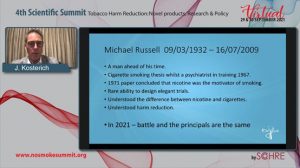Dr Joe Kosterich in his keynote lecture entitled “Two different approaches towards THR – Contrasting the cases of New Zealand & Australia”, successfully demonstrated the superiority of New Zealand’s tobacco control policies, which included THR in decreasing smoking prevalence vis a vis Australia’s strategy.
Australia denounces Harm Reduction and established legislation to make it more difficult to smokers who cannot quit smoking to use THR products to achieve that. Smoking rates in Australia are decreasing but at a much slower rate in comparison to UK & USA. In fact, the annual decline in Australia between 2013 and 2016 is only 0.2%, versus 12% in Iceland 7% in Norway and USA and 5% in the UK. There was no mention of vaping in Australia until 2017, mentions and some debate only started in 2018. Australia has the most expensive cigarettes in the world with cigarette prices constantly increasing for the last thirty years. However, the strategy does not produce good results. Between 2010 and 2013 smokers decreased by 317,000. However, between 2013 and 2016 21,000 more people started smoking. The Government tobacco excise increased from AUD 11.2 billion in 2017 to AUD 15.6 billion in 2021.
In October 2020 a new legislation was put in place in Australia. The Therapeutic Goods Administration announced a decision that from 1st October 2021 the importation of nicotine e-cigarettes and liquid nicotine for vaping will require a valid prescription. The reaction of the state to the increase of the uptake of e-cigarettes by young people led to more restrictions, however following a public consultation. Nicotine products not affected include nicotine replacement therapies currently available without prescription (from pharmacies and some retail outlets including sprays, patches, lozenges, and chews). These products have been assessed by the TGA as safe for retail sale. There are no changes to the availability of e-cigarettes that do not contain nicotine. And of course… Cigarettes. Thus, the cancer and disease provoking combustible cigarettes are provided everywhere but the, a lot less harmful e-cigarettes can only be provided through prescription!
New Zealand on the other hand, has adopted vaping to replace smoking of combustible cigarettes and reduce the caused harm. They devised a large communication campaign with simple understandable messages and facts about vaping, “vaping versus smoking”, “vaping to quit smoking”. “Vaping is not harmful but is much less harmful than smoking. The healthier option is not to vape or smoke. Don’t vape if you don’t smoke. Only vape to quit smoking…”
There is now general agreement that vaping use exposes the user to fewer toxicants than smoking tobacco cigarettes. (McNeill 2015; RCP 2016. Cochrane Review)
As a result of the new strategy in New Zealand, cigarette sales are plunging faster than any time before as smokers turn to alternatives like vaping, with 410 million fewer cigarettes sold annually than just two years before. Dr Murray Laugesen, a trustee of the End Smoking NZ charity, analysed tobacco company returns that are published by the Ministry of Health and found a remarkable drop in sales. About 2,132 million cigarettes were sold in 2019 (193 million fewer than 2018 and following a 217 million drop the previous year). A transition from nicotine patches and gums to e-cigarettes and “heat-not-burn” devices, which heat tobacco to lower temperatures than cigarettes. As Dr George Laking, Chair End Smoking NZ said, “Although electronic cigarettes and heat-not-burn products are not perfect―the best thing is to not use any of these products at all―actually, if we were to convert our smoking epidemic into a situation of people using reduced-harm products, that would actually be a much better situation.”
Michael Russell was the first to understand the difference between nicotine and cigarettes. A man ahead of his time very early understood harm reduction. Currently, in 2021 the principals are the same, but the battle is still on.


